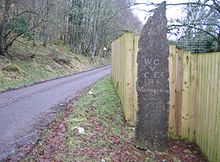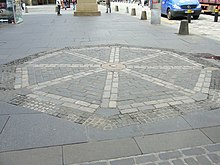Mo rùn geal òg

"Mo rùn geal òg" (My fair young love), alternately known as "Cumha do dh'Uilleam Siseal" (Lament for William Chisholm) is a Scottish Gaelic lament written by Christina Fergusson for her husband, William Chisholm of Strathglass, who was killed at the Battle of Culloden in 1746.
Life
Fergusson was possibly born in Contin, Ross-shire,[1][2] where her father is said, according to Ronald Black, to have been, "a blacksmith - chiefly employed in making dirks and other implements of war."[3] She was married to William Chisholm, who was the Tacksman of Inis nan Ceann, near the modern village of Mauld in Strathglass. Chisholm was also a blacksmith, armourer, and standard bearer for the Chief of Clan Chisholm, to whom he was a very near male relative.[4]
Beginning on 27 May 1700, underground Catholic Bishop Thomas Nicolson had visited Strathglass. In his later Report, the Bishop had described the region, unlike the Hebrides, as so abundant with trees that the local population lived in wattle and daub houses instead of dry stone and thatch blackhouses. The Bishop explained, "They are called Criel Houses, because the larger timbers are interlaced with wickerwork in the same way baskets are made. They are covered outside with sods, or divots. All of the houses on the mainland, wherever we went, are built in this fashion, except those of the lairds and principal gentry. Strathglass is partly inhabited by Frasers, whose chief is Lord Lovat, and partly by Chisholms under the Laird of Strathglass. These latter are all Catholics."[5]
According to Odo Blundell, "When writing of Strathglass on a previous occasion, I mentioned that, 'from the Reformation to the beginning of the [19th-]century, the Catholics in the Aird and in Strathglass received no more support from the two chief families of the neighbourhood, namely, the Frasers and the Chisholms, than was to be expected from the heads of clans who looked upon all their clansmen, whatever might be their religion, as members of their own family."[6]
Between 1735 and the anti-Catholic government crackdown demanded by both the local Presbyterian synod and the General Assembly of the Church of Scotland in 1744, the Catholics of Strathglass were looked after, in defiance of the Penal Laws, by three outlawed Roman Catholic priests of the Society of Jesus; Frs. Charles (Scottish Gaelic: Maighstir Teàrlach, an t-Athair Teàrlach Mac Fhearchair) and John Farquharson (Scottish Gaelic: Maighstir Iain,[7] an-tAthair Iain Mac Fhearchair) and future Catholic martyr Fr. Alexander Cameron (Scottish Gaelic: Maighstir Sandaidh, an t-Athair Alasdair Camshròn).[8]
When Clan Chisholm rose during the Jacobite rising of 1745, William Chisholm joined the Jacobite Army Battalion commanded by the Chief's youngest son, Ruaridh Òg Chisholm. They were allegedly blessed by a Roman Catholic priest before going away to war. A roadside memorial, erected by the Frasers of Mauld near Struy in Strathglass, now marks the site of William and Christina Chisholm's criel house and their last farewell.[9][10] William Chisholm was killed in action after the Battle of Culloden in 1746, allegedly while fighting at the door of a barn to defend the wounded survivors of the Chisholm Battalion from the no quarter that he knew would follow their capture. A total of seven bullet holes are alleged to have afterwards been found in his body.[11] Other sources, according to Ronald Black, name Clan Chisholm's standard bearer at Culloden as John MacDonald, alias (Scottish Gaelic: Iain na Brataich'), who survived the Battle and later emigrated to Canada.[12]
Colin Chisholm of Lietry, on the other hand, writes that the hereditary standard bearers of Clan Chisholm were the (Scottish Gaelic: Mac Iain Idhir) of Carri in Glen Cannich, who claimed descent from a younger son of one of the Chiefs of Clan MacDonnell of Glengarry, and all of whom later emigrated to Canada. The only time that the duty of bearing the Clan Chisholm standard was assigned to anyone other than a Mac Iain Idhir was allegedly right before the Battle of Culloden.[13]

One of the 14 Jacobite battle flags taken at Culloden, which were later burnt at the Mercat Cross in Edinburgh, was the white linen banner of Clan Chisholm, which had been borne by either John MacDonald or William Chisholm.[14]
In her husband's memory, a bereft Ferguson wrote Mo Rùn Geal Òg (My Fair Young Love).[15][16][17][18] In the poem, Christina, while insisting that she is still a loyal Jacobite, rebukes Prince Charles Edward Stuart, saying that the loss of her husband in the fight for a second Stuart Restoration has left her desolate. Literary scholar John MacKenzie later wrote that Christina, "devotes to the Prince one solitary expression of sympathetic condolence... and then, with the wings and wail of a mateless dove, flutters over the mangled carcass of her husband, and depicts his matchless person and soul in language that would melt the sternest heart to sympathy."[19]
In popular culture
- The song has also been covered and recorded by important traditional singers, including Flora MacNeil, Mary Ann Kennedy, Anne Lorne Gillies,[20] and Julie Fowlis.[21]
References
- ^ Mackenzie, John (1909). Sar-obair nam bard Gaelach : the beauties of Gaelic poetry and lives of the Highland bards. Edinburgh: John Grant. pp. 373–4.
- ^ Ewan, Elizabeth; Innes, Sue; Reynolds, Sian, eds. (2006). The biographical dictionary of Scottish women : from the earliest times to 2004 (Reprinted. ed.). Edinburgh: Edinburgh Univ. Press. p. 69. ISBN 0748617132.
- ^ Edited by Ronald Black (2019), An Lasair: Anthology of 18th century Scottish Gaelic Verse, Birlinn Limited. p. 445.
- ^ Edited by Ronald Black (2019), An Lasair: Anthology of 18th century Scottish Gaelic Verse, Birlinn Limited. p. 446.
- ^ Odo Blundell (1917), The Catholic Highlands of Scotland, Volume II, pp. 124-125.
- ^ Odo Blundell (1909), The Catholic Highlands of Scotland, Volume I, London, p. 191.
- ^ Christianity in Strathglass, From the Website for St. Mary's Roman Catholic Church, Beauly.
- ^ MacWilliam, A. S. (1973). A Highland mission: Strathglass, 1671-1777. Innes Review xxiv. pp. 75–102.
- ^ "Chisholm Stone, Mauld". Highland Council HER. Retrieved 29 January 2014.
- ^ Edited by Ronald Black (2019), An Lasair: Anthology of 18th century Scottish Gaelic Verse, Birlinn Limited. pp. 445-446.
- ^ Edited by Ronald Black (2019), An Lasair: Anthology of 18th century Scottish Gaelic Verse, Birlinn Limited. p. 445.
- ^ Edited by Ronald Black (2019), An Lasair: Anthology of 18th century Scottish Gaelic Verse, Birlinn Limited. pp. 445-446.
- ^ "Traditions of Strathglass" (PDF), by Colin Chisholm of Lietry, a series of Victorian era articles about the oral tradition of the region published in The Celtic Magazine. Part V, pp. 182-183.
- ^ Reid, Stuart (2000). Like Hungry Wolves - Culloden Moor 1746. With colour plates by Gerry Embleton. Windrow & Greene Ltd. ISBN 1859150802
- ^ John Stuart Blackie (1889). Scottish Song... W. Blackwood & sons. pp. 234–238. Retrieved 31 January 2014.
- ^ Malcolm Maclean, ed. (2002). Great Book of Gaelic. Canongate U.S. p. 276. ISBN 9781841952505. Retrieved 31 January 2014.
- ^ David Masson (1885). Macmillan's Magazine Volume 52. Macmillan and Company. pp. 309–310. Retrieved 31 January 2014.
- ^ John T. Koch, ed. (2006). Celtic Culture: A Historical Encyclopedia. ABC-CLIO. p. 1033. ISBN 9781851094400. Retrieved 31 January 2014.
- ^ Edited by Ronald Black (2019), An Lasair: Anthology of 18th century Scottish Gaelic Verse, Birlinn Limited. p. 446.
- ^ "Mo Rùn Geal Òg". Bliadhna nan Òran (in Scottish Gaelic). BBC. Retrieved 19 May 2019.
- ^ "Duncan Chisholm, Liz Doherty & Julie Fowlis - Mo Rùn Geal Òg". BBC Alba. 13 January 2017. Retrieved 2 October 2023.
